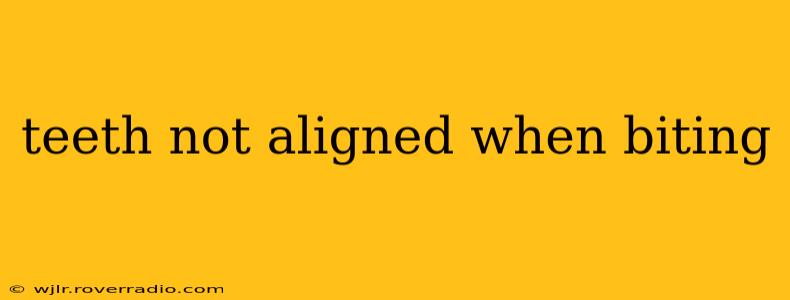Having your teeth not aligned when biting, a condition known as malocclusion, is more common than you might think. It's not just an aesthetic concern; misaligned teeth can impact your chewing, speech, and even your jaw health. This comprehensive guide will explore the various types of malocclusion, their causes, and treatment options. We'll also address some frequently asked questions to provide a complete understanding of this dental issue.
What Causes Teeth Not Aligning When Biting?
The causes of malocclusion are multifaceted and can involve a combination of genetic and environmental factors. These factors can influence the development of your jaw and the positioning of your teeth throughout childhood and adolescence.
-
Genetics: Inheritance plays a significant role. If your parents or other family members had malocclusion, you're more likely to experience it as well. Genetic factors can influence jaw size and shape, impacting how your teeth fit together.
-
Thumb Sucking: Prolonged thumb sucking, especially past the age of four or five, can significantly affect tooth alignment. The constant pressure on the teeth and jaws can push them out of position.
-
Pacifier Use: Similar to thumb sucking, prolonged pacifier use can contribute to malocclusion. The constant sucking pressure can affect the developing jaw and teeth alignment.
-
Early Tooth Loss: Losing baby teeth prematurely can cause adjacent teeth to shift into the empty space, disrupting the normal alignment.
-
Mouth Breathing: Habitual mouth breathing can affect facial development and tooth alignment.
-
Trauma: Injuries to the mouth or jaw can displace teeth, leading to misalignment.
What are the Different Types of Malocclusion?
There are several types of malocclusion, each with its own characteristics:
-
Overbite (Deep Bite): The upper front teeth significantly overlap the lower front teeth.
-
Underbite (Class III Malocclusion): The lower jaw protrudes beyond the upper jaw.
-
Crossbite: The upper teeth bite inside the lower teeth, or vice versa.
-
Open Bite: A gap exists between the upper and lower teeth when biting down.
-
Crowding: Teeth are too close together, often resulting in overlapping or crooked teeth.
-
Spacing: Gaps exist between teeth.
How is Malocclusion Diagnosed?
A dentist or orthodontist will diagnose malocclusion through a thorough oral examination. This typically involves:
- Visual Examination: Assessing the alignment of your teeth and jaws.
- X-rays: To evaluate the roots of your teeth and the development of your jawbone.
- Models: Taking impressions of your teeth to create models for detailed analysis.
What are the Treatment Options for Misaligned Teeth?
Treatment options vary depending on the severity and type of malocclusion, as well as the patient's age. Common treatments include:
-
Braces: Traditional metal braces, ceramic braces, or lingual braces (placed behind the teeth) are commonly used to straighten teeth.
-
Invisalign: Clear aligners are a less visible alternative to traditional braces.
-
Headgear: Used in conjunction with braces, headgear applies gentle pressure to reposition the jaw.
-
Retainers: Worn after braces or Invisalign to maintain the corrected tooth alignment.
What are the Long-Term Effects of Untreated Malocclusion?
Leaving malocclusion untreated can lead to several long-term issues, including:
-
Increased risk of cavities and gum disease: Misaligned teeth can make it difficult to clean effectively, leading to plaque buildup and periodontal problems.
-
TMJ disorders: Temporomandibular joint disorders (TMJ) can result from misalignment of the jaw, causing pain and discomfort.
-
Difficulty chewing and speaking: Misaligned teeth can interfere with proper chewing and speech.
-
Low self-esteem: The appearance of misaligned teeth can affect a person's self-confidence.
Does Malocclusion Affect Speech?
Yes, severe malocclusion can indeed affect speech. The position of the teeth and jaws plays a vital role in the production of certain sounds. Misalignment can lead to lisps or other speech impediments. Orthodontic treatment can often improve speech clarity.
Can Malocclusion Be Prevented?
While some genetic factors are unavoidable, good oral hygiene practices and regular dental check-ups can help prevent some forms of malocclusion. Addressing early tooth loss and avoiding prolonged thumb sucking or pacifier use are also crucial preventative measures.
How Much Does Malocclusion Treatment Cost?
The cost of malocclusion treatment varies greatly depending on the complexity of the case, the type of treatment chosen, and the orthodontist's fees. It's essential to consult with an orthodontist for a personalized assessment and cost estimate.
This information is for general knowledge and does not constitute medical advice. Always consult with a qualified dental professional for diagnosis and treatment of any dental condition.
